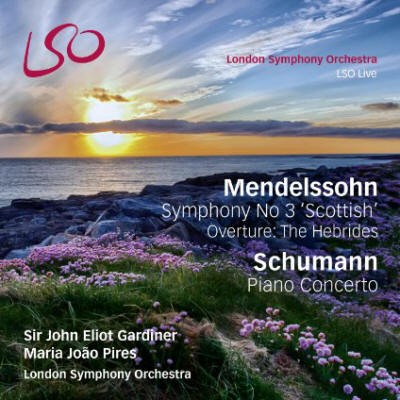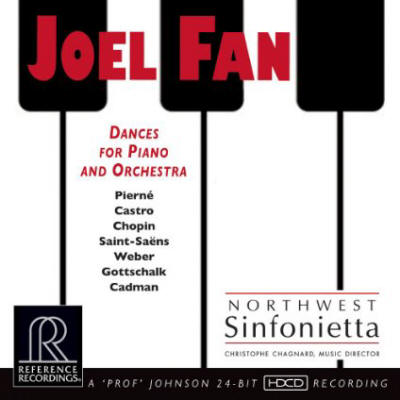You are reading the older HTML site
Positive Feedback ISSUE 78
New Music
Vol. No. 79 Composer: Felix Mendelssohn, Compositions: Symphony No.3 ‘Scottish': Overture The Hebrides. Composer: Schumann. Composition: Piano Concerto. Conductor: John Eliot Gardiner. Orchestra: London Symphony. BD/SACD: LSO0765 First let me take care of the numbering system for this recording listed above. It looks unusual because it simply is. This recording comes with two complete discs. BD is simply for the Blu-ray disc. That as usual is high definition audio and video. The SACD disc is simply high definition audio only and is actually or simply a different system than Blu-ray and they are not compatible. Whichever you have in your system, you will now have the disc to play on it, plus a spare for the other system that you may put to use in the future. Both discs are quite excellent and very definitely full range audio. This release is the start of the much-anticipated series exploring the complete symphonies of Mendelssohn and conducted by John Eliot Gardiner. Mendelssohn did travel to the British Isles and fully influenced by Scotland, wrote his Symphony No. 3, Scottish, and the well-known and loved Overture, The Hebrides. These are two of Mendelssohn's most popular compositions and I fully agree with that assessment. If you're going to have Mendelssohn in your personal recorded collection, these two have to be included. Also consider Mendelssohn's beautiful Violin Concerto. To fill in the background information, the Hebrides are groups of islands, outer and inner, north and west of Scotland. Many of the inner group are very close to the mainland. It will be easy to guess that one or more months are rough living experiences there. There is one other bit of geography that should be mentioned as it is part of the musical landscape; it is the very large and well known Fingal's Cave that is located in the inner group of the Hebrides Islands in Staffa Island. There had been much discussion about the source of the name Fingal. Some think it is an eponymous name from a fictitious literary hero and not certain. Purchase of this outstanding recording actually winds up giving you two discs! Disc 1 (Pure Audio…Blu-ray): 5.0 DTS-HD Master Audio 24/bit192kHz and 2.0 LPCM 24 192kHz and includes bonus video. Disc 2 (SACD hybrid) includes 2.0 stere+5.0 multi-channel mixes. Notes in English, French, German. The London Symphony Orchestra is probably the most recorded orchestra in the world. The reason is they do much of the background music for movies and theatre work which you see and go to. They do not enjoy as many auditoriums and recording studios that will be on hand for an orchestra as orchestras in other cities may have. (London is well known for a shortage of large performing/recording facilities). They are always trying to get the best possible audio quality in their recordings. They are doing something different in this release and if you are a serious listener and are hearing an improvement, let them know. I will not comment now.
Dances for Piano and Orchestra, Joel Fan: Piano. Northwest Sinfornietta, Christophe Chagnard: Music Director. Reference Recordings # RR-134 1. Gabriel Pierne: Fantaisie-Ballet, Op.6 2. Ricardo Castro Herrera: Vals Capricho, Op. 1 3. Fryderyk Chopin: Krakowiak in F Major, Op. 14 4. Camille Saint-Saens: Valse-Caprice in A-flat Major ("Wedding Cake"), Op. 76 5. Carl Maria von Weber/Liszt: Polonaise Brillante, Op. 72 6. Louis Moreau Gottschalk/Kay: Grand Tarantelle, Op. 67 7. Charles Wakefield Cadman: Dark Dancers of the Mardi Gras (Fantasy for Orchestra with Piano)
There is a rather unusual reason for my listing and not really reviewing the above "dances." Composers are currently active composing new music, dances included. Listen often so that you can spot other works by any of these composers from the above listed group. Some of, and I mean some parts of each of the dance compositions, will be found in current and future compositions by each of the composers. That might slightly shock you; there is a logical business side of music, and even to the writing of it. Get very familiar with all of the dances so that you will spot sections of the dances in other places now, and in the future. Of course the most logical places will be other compositions, new or previous by the same composer. Let this be a bit of a learning experience as you work at finding sections of these dances in new and other compositions, often with simply minor changes. Many years ago, as symphonies got created, there were some unwritten things that would be done. Second movement of newly composed symphonies were to be melodic music that was in some dance or danceable form. The first movement was always an introduction to some, or all of the the rest of the Symphony movements. Almost always a total of four movements in the older symphonies and often part of the dance movement, second movement, areas would be found in one form or another in the third or fourth movements. Finding sections of the dances in new compositions, and often with only minor changes, will give you a feeling of accomplishment. Continue to learn about music, not just to play it.
|



